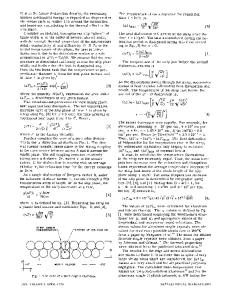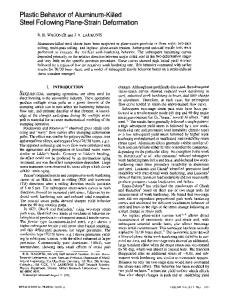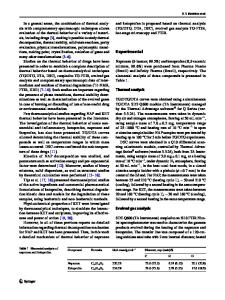Thermal and plastic behavior of nanoglasses
- PDF / 614,534 Bytes
- 7 Pages / 584.957 x 782.986 pts Page_size
- 102 Downloads / 295 Views
Daniel Leisen Institute for Applied Materials, Karlsruhe Institute of Technology (KIT), 76344 Eggenstein-Leopoldshafen, Germany
Herbert Gleiter Herbert Gleiter Institute of Nanoscience of the Nanjing University of Science and Technology, Nanjing, China; and Institute for Nanotechnology, Karlsruhe Institute of Technology (KIT), 76344 Eggenstein-Leopoldshafen, Germany
Horst Hahn Institute for Nanotechnology, Karlsruhe Institute of Technology (KIT), Eggenstein-Leopoldshafen, Germany; and KIT-TUD Joint Research Laboratory Nanomaterials, Institute of Materials Science, Technische Universitaet Darmstadt (TUD), 64287 Darmstadt, Germany (Received 1 October 2013; accepted 29 April 2014)
The mechanical and thermal behavior of nanoglasses (NGs) were studied with a focus on the effect of the microstructure. The thermal expansion was measured to track changes in excess free volume during heating. It was found that the excess free volume, which is initially more dominant in the interphase region between the denser amorphous particles, is partially lost as well as redistributed during annealing. This relaxation during heating causes the nanoglass to behave like a melt-spun ribbon after heating while remaining amorphous. Nanomechanical tests were used to probe the local incipient plasticity and the influence of the interphase region. This interphase appears to affect the mechanical response of the NGs by inhibiting the propagation of shear bands and thus offers a novel approach for the introduction of plasticity in bulk metallic glasses. The results suggest that the NGs consist of two distinct amorphous phases with different glass transition temperatures.
I. INTRODUCTION
Nanoglasses (NGs) constitute a new subcategory of amorphous materials with a wide range of interesting properties including changes in their magnetic and mechanical behavior.1 While regular metallic glasses are obtained by freezing the liquid state in a quenching or rapid cooling process. NGs are created by inert gas condensation leading to small amorphous particulates that can be compressed and “sintered” into a bulk material.1–4 NGs can also be generated by severe plastic deformation of bulk metallic glasses (BMGs)5 and recently by magnetron sputtering using powder targets.6 It was found experimentally that NGs exhibit a higher intermediate range order than BMGs.3 Molecular dynamics (MD) simulations and experimental results for NG structures revealed that the interphase region between the particles contains a significantly larger fraction of excess free volume than the particles,2,7,8 which is considered to be the main reason for the changed response of the material.
a)
Address all correspondence to this author. e-mail: [email protected] DOI: 10.1557/jmr.2014.101 1210
J. Mater. Res., Vol. 29, No. 10, May 28, 2014
http://journals.cambridge.org
Downloaded: 06 Jun 2014
Typical BMGs usually fail catastrophically by shear banding once a critical stress is surpassed.9–11 Once the socalled shear transition zones are activated, their avalanchelike propagation cre
Data Loading...











